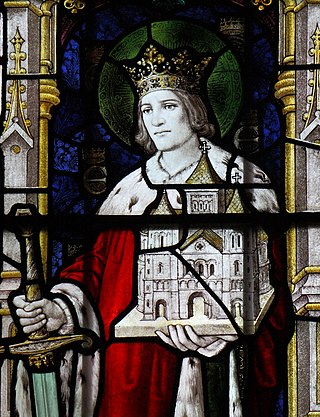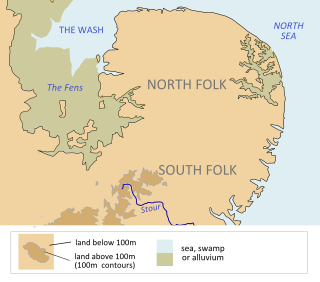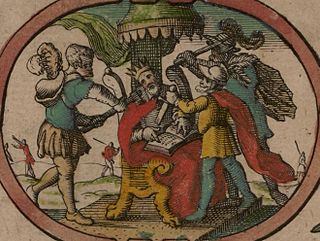
Rædwald, also written as Raedwald or Redwald, was a king of East Anglia, an Anglo-Saxon kingdom which included the present-day English counties of Norfolk and Suffolk. He was the son of Tytila of East Anglia and a member of the Wuffingas dynasty, who were the first kings of the East Angles. Details about Rædwald's reign are scarce, primarily because the Viking invasions of the 9th century destroyed the monasteries in East Anglia where many documents would have been kept. Rædwald reigned from about 599 until his death around 624, initially under the overlordship of Æthelberht of Kent. In 616, as a result of fighting the Battle of the River Idle and defeating Æthelfrith of Northumbria, he was able to install Edwin, who was acquiescent to his authority, as the new king of Northumbria. During the battle, both Æthelfrith and Rædwald's son, Rægenhere, were killed.
Oswiu, also known as Oswy or Oswig, was King of Bernicia from 642 and of Northumbria from 654 until his death. He is notable for his role at the Synod of Whitby in 664, which ultimately brought the church in Northumbria into conformity with the wider Catholic Church.

Wulfhere or Wulfar was King of Mercia from 658 until 675 AD. He was the first Christian king of all of Mercia, though it is not known when or how he converted from Anglo-Saxon paganism. His accession marked the end of Oswiu of Northumbria's overlordship of southern England, and Wulfhere extended his influence over much of that region. His campaigns against the West Saxons led to Mercian control of much of the Thames valley. He conquered the Isle of Wight and the Meon valley and gave them to King Æthelwealh of the South Saxons. He also had influence in Surrey, Essex, and Kent. He married Eormenhild, the daughter of King Eorcenberht of Kent.

Edwin, also known as Eadwine or Æduinus, was the King of Deira and Bernicia – which later became known as Northumbria – from about 616 until his death. He converted to Christianity and was baptised in 627. After he fell at the Battle of Hatfield Chase, he was venerated as a saint.
Æthelhere was King of East Anglia from 653 or 654 until his death. He was a member of the ruling Wuffingas dynasty and one of three sons of Eni to rule East Anglia as Christian kings. He was a nephew of Rædwald, who was the first of the Wuffingas of which more than a name is known.

Anna was king of East Anglia from the early 640s until his death. He was a member of the Wuffingas family, the ruling dynasty of the East Angles, and one of the three sons of Eni who ruled the kingdom of East Anglia, succeeding some time after Ecgric was killed in battle by Penda of Mercia. Anna was praised by Bede for his devotion to Christianity and was renowned for the saintliness of his family: his son Jurmin and all his daughters – Seaxburh, Æthelthryth, Æthelburh and possibly a fourth, Wihtburh – were canonised.
Tytila was a semi-historical pagan king of East Anglia, a small Anglo-Saxon kingdom which today includes the English counties of Norfolk and Suffolk. Early sources, including Bede's Ecclesiastical History of the English People, identify him as an early member of the Wuffingas dynasty who succeeded his father Wuffa. A later chronicle dates his reign from 578, but he is not known to have definitely ruled as king and nothing of his life is known. He is listed in a number of genealogical lists.
Ecgric was a king of East Anglia, the independent Anglo-Saxon kingdom that today includes the English counties of Norfolk and Suffolk. He was a member of the ruling Wuffingas dynasty, but his relationship with other known members of the dynasty is not known with any certainty. Anna of East Anglia may have been his brother, or his cousin. It has also been suggested that he was identical with Æthelric, who married the Northumbrian princess Hereswith and was the father of Ealdwulf of East Anglia. The primary source for the little that is known about Ecgric's life is Historia ecclesiastica gentis Anglorum, written by the English Benedictine monk Bede in around 731 AD.

The Wuffingas, Uffingas or Wiffings were the ruling dynasty of East Anglia, the long-lived Anglo-Saxon kingdom which today includes the English counties of Norfolk and Suffolk. The Wuffingas took their name from Wuffa, an early East Anglian king. Nothing is known of the members of the dynasty before Rædwald, who ruled from about 599 to c.624. The Viking invasions of the ninth century or dissolution of the monasteries in the 16th century may have led to the destruction of the documents relating to the rule of the Wuffingas.
Ealdwulf was king of East Anglia from c. 664 to 713. He was the son of Hereswitha, a Northumbrian princess, and of Æthilric, whose brothers all ruled East Anglia during the 7th century. Ealdwulf recalled that when he was very young, he saw the Christian/pagan temple belonging to his ancestor Rædwald.

Felix of Burgundy, also known as Felix of Dunwich, was a saint and the first bishop of the kingdom of the East Angles. He is widely credited as the man who introduced Christianity to the kingdom. Almost all that is known about him comes from The Ecclesiastical History of the English People, completed by the English historian Bede in about 731, and the Anglo-Saxon Chronicle. Bede wrote that Felix freed "the whole of this kingdom from long-standing evil and unhappiness".
Sigeberht of East Anglia, was a saint and a king of East Anglia, the Anglo-Saxon kingdom which today includes the English counties of Norfolk and Suffolk. He was the first English king to receive a Christian baptism and education before his succession and the first to abdicate in order to enter the monastic life. The principal source for Sigeberht is Bede's Ecclesiastical History of the English People, which was completed in the 730s.

Eorpwald; also Erpenwald or Earpwald,, succeeded his father Rædwald as ruler of the independent Kingdom of the East Angles. Eorpwald was a member of the East Anglian dynasty known as the Wuffingas, named after the semi-historical king Wuffa.

Eni or Ennius was a member of the Wuffing family, the ruling dynasty of the kingdom of East Anglia. He was the son of the semi-historical pagan king Tyttla and the brother of Rædwald, who both ruled East Anglia.
Æthelwold, also known as Æthelwald or Æþelwald, was a 7th-century king of East Anglia, the long-lived Anglo-Saxon kingdom which today includes the English counties of Norfolk and Suffolk. He was a member of the Wuffingas dynasty, which ruled East Anglia from their regio at Rendlesham. The two Anglo-Saxon cemeteries at Sutton Hoo, the monastery at Iken, the East Anglian see at Dommoc and the emerging port of Ipswich were all in the vicinity of Rendlesham.

Dommoc, a place not certainly identified but probably within the modern county of Suffolk, was the original seat of the Anglo-Saxon bishops of the Kingdom of East Anglia. It was established by Sigeberht of East Anglia for Saint Felix in c. 629–31. It remained the bishopric of all East Anglia until c. 673, when Theodore of Tarsus, Archbishop of Canterbury, divided the see and created a second bishopric at either North Elmham, Norfolk, or South Elmham, Suffolk. The see of Dommoc continued to exist until the time of the Viking Wars of the 860s, after which it lapsed.
Hereswith or Hereswitha, also spelt Hereswithe, Hereswyde or Haeresvid, was a 7th-century Northumbrian saint. She married into the East Anglian royal dynasty and afterwards retired to Gaul to lead a religious life. Hereswith's sister was Saint Hilda, founder of the monastery at Whitby. Details of her life and identity come from Bede's Historia Ecclesiastica, the Anglian collection and the Lives of Edwin of Northumbria and Hilda of Whitby.

The Kingdom of the East Angles, today known as the Kingdom of East Anglia, was a small independent kingdom of the Angles comprising what are now the English counties of Norfolk and Suffolk and perhaps the eastern part of the Fens. The kingdom formed in the 6th century in the wake of the Anglo-Saxon settlement of Britain. It was ruled by the Wuffingas dynasty in the 7th and 8th centuries, but fell to Mercia in 794, and was conquered by the Danes in 869, to form part of the Danelaw. It was conquered by Edward the Elder and incorporated into the Kingdom of England in 918.
The Christianisation of Anglo-Saxon England was a process spanning the 7th century. It was essentially the result of the Gregorian mission of 597, which was joined by the efforts of the Hiberno-Scottish mission from the 630s. From the 8th century, the Anglo-Saxon mission was, in turn, instrumental in the conversion of the population of the Frankish Empire.











